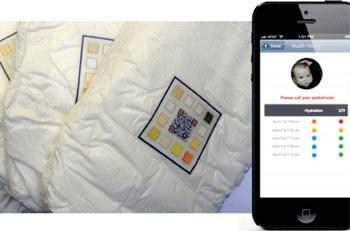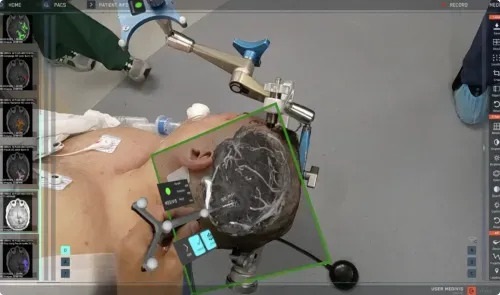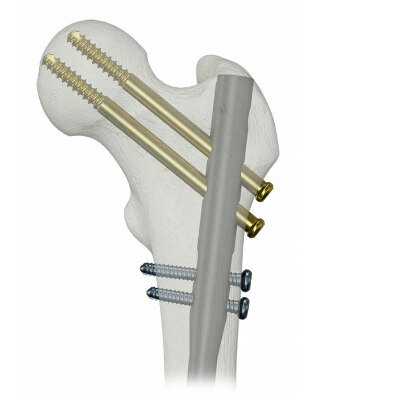Diapers with Test Strips Help Spot Developing Disease
|
By HospiMedica International staff writers Posted on 24 Jul 2013 |

Image: Smart diapers and the accompanying app (Photo courtesy of Pixie Scientific).
Sophisticated diapers with built-in test strips could alert to medical conditions that require immediate attention.
Smart diapers are an unobtrusive method of tracking a child’s health via home urinalysis. As the child urinates, the liquid makes contact with a square QR code that has test strips surrounding it; there is also a neutral white square, to more easily check for color changes in the other squares. Once the colors have settled, a picture is taken of the strips and QR code. A complimentary smartphone app automatically recognizes the colors and their location relative to the code, and provides output on any potential medical conditions, including urinary tract infections, prolonged dehydration, or signs of kidney problems.
All these conditions that often affect babies can be detected through the use of urine test strips, but such strips are cumbersome to use, especially with babies, who do not urinate on command. By using the Smart diaper, parents do not have wait for the child to pee, or go through the unpleasant task of squeezing urine drops out of soiled diapers onto test strips. The diapers can also help parents track a sick child's health for months or years, automatically looking for emerging trends.
The test pad area contains reagents that interact with leukocytes and nitrites generated by bacteria. The reagents and the dyes formed as a result of reaction with urine content are not toxic and never come in direct contact with the child’s skin, since they are positioned over the absorbent core and the inner layer of the diaper, which does not let liquid back in. The Smart Diaper is under development by Pixie Scientific (New York, NY, USA), and is expected to be tested at Benioff Children’s Hospital (San Francisco, CA, USA) in September 2013.
“I was driving with my wife and daughter one day, when my wife asked if the baby had wet herself; I realized she was sitting in data,” said Yaroslav Faybishenko, Pixie’s founder. “We could use special engineered diapers and require data before the visible symptoms set in and to try to understand the onset of any chronic conditions before simply before the symptoms are visible.”
Related Links:
Pixie Scientific
Benioff Children’s Hospital
Smart diapers are an unobtrusive method of tracking a child’s health via home urinalysis. As the child urinates, the liquid makes contact with a square QR code that has test strips surrounding it; there is also a neutral white square, to more easily check for color changes in the other squares. Once the colors have settled, a picture is taken of the strips and QR code. A complimentary smartphone app automatically recognizes the colors and their location relative to the code, and provides output on any potential medical conditions, including urinary tract infections, prolonged dehydration, or signs of kidney problems.
All these conditions that often affect babies can be detected through the use of urine test strips, but such strips are cumbersome to use, especially with babies, who do not urinate on command. By using the Smart diaper, parents do not have wait for the child to pee, or go through the unpleasant task of squeezing urine drops out of soiled diapers onto test strips. The diapers can also help parents track a sick child's health for months or years, automatically looking for emerging trends.
The test pad area contains reagents that interact with leukocytes and nitrites generated by bacteria. The reagents and the dyes formed as a result of reaction with urine content are not toxic and never come in direct contact with the child’s skin, since they are positioned over the absorbent core and the inner layer of the diaper, which does not let liquid back in. The Smart Diaper is under development by Pixie Scientific (New York, NY, USA), and is expected to be tested at Benioff Children’s Hospital (San Francisco, CA, USA) in September 2013.
“I was driving with my wife and daughter one day, when my wife asked if the baby had wet herself; I realized she was sitting in data,” said Yaroslav Faybishenko, Pixie’s founder. “We could use special engineered diapers and require data before the visible symptoms set in and to try to understand the onset of any chronic conditions before simply before the symptoms are visible.”
Related Links:
Pixie Scientific
Benioff Children’s Hospital
Latest Patient Care News
- First-Of-Its-Kind Portable Germicidal Light Technology Disinfects High-Touch Clinical Surfaces in Seconds
- Surgical Capacity Optimization Solution Helps Hospitals Boost OR Utilization

- Game-Changing Innovation in Surgical Instrument Sterilization Significantly Improves OR Throughput
- Next Gen ICU Bed to Help Address Complex Critical Care Needs
- Groundbreaking AI-Powered UV-C Disinfection Technology Redefines Infection Control Landscape
- Clean Hospitals Can Reduce Antibiotic Resistance, Save Lives
- Smart Hospital Beds Improve Accuracy of Medical Diagnosis
- New Fast Endoscope Drying System Improves Productivity and Traceability
- World’s First Automated Endoscope Cleaner Fights Antimicrobial Resistance
- Portable High-Capacity Digital Stretcher Scales Provide Precision Weighing for Patients in ER
- Portable Clinical Scale with Remote Indicator Allows for Flexible Patient Weighing Use
- Innovative and Highly Customizable Medical Carts Offer Unlimited Configuration Possibilities
- Biomolecular Wound Healing Film Adheres to Sensitive Tissue and Releases Active Ingredients
- Wearable Health Tech Could Measure Gases Released From Skin to Monitor Metabolic Diseases
- Wearable Cardioverter Defibrillator System Protects Patients at Risk of Sudden Cardiac Arrest
- World's First AI-Ready Infrasound Stethoscope Listens to Bodily Sounds Not Audible to Human Ear
Channels
Artificial Intelligence
view channel
AI-Powered Algorithm to Revolutionize Detection of Atrial Fibrillation
Atrial fibrillation (AFib), a condition characterized by an irregular and often rapid heart rate, is linked to increased risks of stroke and heart failure. This is because the irregular heartbeat in AFib... Read more
AI Diagnostic Tool Accurately Detects Valvular Disorders Often Missed by Doctors
Doctors generally use stethoscopes to listen for the characteristic lub-dub sounds made by heart valves opening and closing. They also listen for less prominent sounds that indicate problems with these valves.... Read moreCritical Care
view channel.jpeg)
Transcatheter Valve Replacement Outcomes Similar To Surgery, Finds Study
A new study has shown that a minimally invasive procedure for replacing the aortic valve in the heart—known as transcatheter aortic valve replacement (TAVR)—is on par with the more traditional surgical... Read more
Revascularization Improves Life Quality in Chronic Limb-Threatening Ischemia, Finds Study
Researchers have undertaken a detailed study to evaluate the effects of revascularization strategies on the health-related quality of life (HRQoL) of patients with chronic limb-threatening ischemia.... Read moreSurgical Techniques
view channel
AR Surgical Technology Translates Complex 2D Medical Imaging to Enhance Accuracy
Surgeons often have to switch their focus between a patient’s data displayed on a screen or clipboard and the patient themselves during procedures. But that is about to change. Surgeons can now utilize... Read more
Miniaturized Snake-Like Probe Images Cerebral Arteries From Within
Endovascular interventions are being increasingly favored for treating strokes and cerebral artery diseases, but rely heavily on angiographical imaging that often struggles with limited contrast and spatial... Read moreHealth IT
view channel
Machine Learning Model Improves Mortality Risk Prediction for Cardiac Surgery Patients
Machine learning algorithms have been deployed to create predictive models in various medical fields, with some demonstrating improved outcomes compared to their standard-of-care counterparts.... Read more
Strategic Collaboration to Develop and Integrate Generative AI into Healthcare
Top industry experts have underscored the immediate requirement for healthcare systems and hospitals to respond to severe cost and margin pressures. Close to half of U.S. hospitals ended 2022 in the red... Read more
AI-Enabled Operating Rooms Solution Helps Hospitals Maximize Utilization and Unlock Capacity
For healthcare organizations, optimizing operating room (OR) utilization during prime time hours is a complex challenge. Surgeons and clinics face difficulties in finding available slots for booking cases,... Read more
AI Predicts Pancreatic Cancer Three Years before Diagnosis from Patients’ Medical Records
Screening for common cancers like breast, cervix, and prostate cancer relies on relatively simple and highly effective techniques, such as mammograms, Pap smears, and blood tests. These methods have revolutionized... Read morePoint of Care
view channel
Critical Bleeding Management System to Help Hospitals Further Standardize Viscoelastic Testing
Surgical procedures are often accompanied by significant blood loss and the subsequent high likelihood of the need for allogeneic blood transfusions. These transfusions, while critical, are linked to various... Read more
Point of Care HIV Test Enables Early Infection Diagnosis for Infants
Early diagnosis and initiation of treatment are crucial for the survival of infants infected with HIV (human immunodeficiency virus). Without treatment, approximately 50% of infants who acquire HIV during... Read more
Whole Blood Rapid Test Aids Assessment of Concussion at Patient's Bedside
In the United States annually, approximately five million individuals seek emergency department care for traumatic brain injuries (TBIs), yet over half of those suspecting a concussion may never get it checked.... Read more
New Generation Glucose Hospital Meter System Ensures Accurate, Interference-Free and Safe Use
A new generation glucose hospital meter system now comes with several features that make hospital glucose testing easier and more secure while continuing to offer accuracy, freedom from interference, and... Read moreBusiness
view channel
Johnson & Johnson Acquires Cardiovascular Medical Device Company Shockwave Medical
Johnson & Johnson (New Brunswick, N.J., USA) and Shockwave Medical (Santa Clara, CA, USA) have entered into a definitive agreement under which Johnson & Johnson will acquire all of Shockwave’s... Read more

















